Coupling Coordination Relationship and Driving Factors Between Common Prosperity and Tourism Development Levels in the Five Northwestern Provinces of China
Abstract
1. Introduction
2. Materials and Methods
2.1. Study Area
2.2. Indicator System Construction
2.3. Research Methodology
2.3.1. Entropy Weight Method
2.3.2. Coupling Coordination Model
2.3.3. Geographically and Temporally Weighted Regression Model
3. Results
3.1. Spatiotemporal Characteristics of Common Prosperity and Tourism Development Levels
3.2. Spatiotemporal Characteristics of Coupling Coordination Between Common Prosperity and Tourism Development Levels
3.3. Spatiotemporal Analysis of Driving Factors of Coupling Coordination
3.3.1. Temporal Analysis of Driving Factors
3.3.2. Spatial Analysis of Driving Factors
4. Discussion
5. Conclusions
Author Contributions
Funding
Data Availability Statement
Conflicts of Interest
Abbreviations
| GTWR | Geographically and Temporally Weighted Regression |
| GDP | Gross Domestic Product |
| CNY | Chinese Yuan (Renminbi) |
| OLS | Ordinary Least Squares Regression |
References
- Xi, J. Holding high the great banner of socialism with Chinese characteristics and striving together to build a modern socialist country in an allround way: Report at the 20th National Congress of the Communist Party of China. People’s Daily, 26 October 2022. [Google Scholar]
- Feng, L.L.; Zhong, H. Interrelationships and Methods for Improving University Students’ Sense of Gain, Sense of Security, and Happiness. Front. Psychol. 2021, 12, 729400. [Google Scholar] [CrossRef] [PubMed]
- Kumail, T.; Sadiq, M.; Ali, W.; Sadiq, F. The impacts of tourism development on income inequality: How does tourism capital investment contribute to income distribution? Tourism Agenda 2030. Tour. Rev. 2023, 78, 630–645. [Google Scholar] [CrossRef]
- Liu, Y.; Dong, K.; Wang, J.; Taghizadeh-Hesary, F. Towards sustainable development goals: Does common prosperity contradict carbon reduction? Econ. Anal. Policy 2023, 79, 70–88. [Google Scholar] [CrossRef]
- Ma, X.F.; Zhang, R.; Ruan, Y.F. Evaluation of common prosperity level and regional difference based on the background of green development. Sustainability 2022, 14, 15863. [Google Scholar] [CrossRef]
- Dunford, M. The Chinese path to common prosperity. Int. Crit. Thought 2022, 12, 35–54. [Google Scholar] [CrossRef]
- Li, S. Understanding China’s road to common prosperity: Background, definition and path. China Econ. J. 2023, 16, 1–13. [Google Scholar] [CrossRef]
- Zhu, C.; Wang, Z.; Jiang, Q.; Xie, C. Does industry monopolization widen wage residual inequality in China? Int. Rev. Econ. Financ. 2024, 96, 103503. [Google Scholar] [CrossRef]
- Sun, Y.; Zhou, L.; Wang, D.; Jin, K.; Wu, Q.; Wu, R. How economic policy uncertainty affects common prosperity in China? The mediating role of green finance and the moderating role of low-carbon technology. Financ. Res. Lett. 2024, 67, 105701. [Google Scholar] [CrossRef]
- Xie, T.; Zhang, Y.; Song, X. Research on the spatiotemporal evolution and influencing factors of common prosperity in China. Environ. Dev. Sustain. 2024, 26, 1851–1877. [Google Scholar] [CrossRef]
- Deng, Y.; Li, C.; Wang, S.; Tang, R. The Impact of Economic Openness on Common Prosperity: Insights from Provincial Panel Data. Int. Rev. Econ. Financ. 2025, 98, 103908. [Google Scholar] [CrossRef]
- Liu, J.; Nijkamp, P.; Lin, D. Urban-rural imbalance and tourism-led growth in China. Ann. Tour. Res. 2017, 64, 24–36. [Google Scholar] [CrossRef]
- Zeng, K.; Luo, X. China’s inbound tourist revenue and Beijing Olympic Games 2008. China World Econ. 2008, 16, 110–126. [Google Scholar] [CrossRef]
- Yan, X.; Luo, M.; Zhong, C. Evaluation of rural tourism development level based on entropy-weighted grey correlation analysis: The case of Jiangxi Province. Grey Syst. Theory Appl. 2023, 13, 677–700. [Google Scholar] [CrossRef]
- Zhang, L.; Marzuki, A.; Liao, Z. The coordination pattern of tourism efficiency and development level in Guangdong Province under high-quality development. Humanit. Soc. Sci. Commun. 2023, 10, 796. [Google Scholar] [CrossRef]
- Chen, Q.; Chen, W.; Wu, D.; Zheng, L.; Li, J. Spatiotemporal evolution and influencing factors of tourism development efficiency in the Yangtze River Economic Belt, China. J. Clean. Prod. 2022, 379, 134722. [Google Scholar] [CrossRef]
- Ji, J.; Wang, D. Regional differences, dynamic evolution, and driving factors of tourism development in Chinese coastal cities. Ocean. Coast. Manag. 2022, 226, 106262. [Google Scholar] [CrossRef]
- Li, K.X.; Jin, M.; Shi, W. Tourism as an important impetus to promoting economic growth: A critical review. Tour. Manag. Perspect. 2018, 26, 135–142. [Google Scholar] [CrossRef]
- Kim, J.H.; Kang, K.H. The interaction effect of tourism and foreign direct investment on urban–rural income disparity in China: A comparison between autonomous regions and other provinces. In Current Issues in Asian Tourism: Volume II; Routledge: London, UK, 2021; pp. 204–217. [Google Scholar]
- Tang, C.F.; Tan, E.C. Does tourism effectively stimulate malaysia’s economic growth? Tour. Manag. 2015, 46, 158–163. [Google Scholar] [CrossRef]
- Comerio, N.; Pacicco, F. The role of tourism in reducing economic inequalities: The case of Italy. Econ. Politica 2024, 41, 839–880. [Google Scholar] [CrossRef]
- Zhang, J. The effects of tourism on income inequality: A meta-analysis of econometrics studies. J. Hosp. Tour. Manag. 2021, 48, 312–321. [Google Scholar] [CrossRef]
- Ahmad, A. The constraints of tourism development for a cultural heritage destination: The case of Kampong Ayer (Water Village) in Brunei Darussalam. Tour. Manag. Perspect. 2013, 8, 106–113. [Google Scholar] [CrossRef]
- Fan, T.; Xue, D. Spatial correlation of cultural industry and tourism industry in Shaanxi Province, China: LISA analysis based on coordination model. Asia Pac. J. Tour. Res. 2020, 25, 967–980. [Google Scholar] [CrossRef]
- Yang, Y.; Zhang, C.; Qin, Z.; Cui, Y. The spatial-temporal pattern evolution and influencing factors of county-scale tourism efficiency in Xinjiang, China. Open Geosci. 2022, 14, 1547–1561. [Google Scholar] [CrossRef]
- Liu, H.; Hasan, M.; Cui, D.; Yan, J.; Sun, G. Evaluation of tourism competitiveness and mechanisms of spatial differentiation in Xinjiang, China. PLoS ONE 2022, 17, e0263229. [Google Scholar] [CrossRef] [PubMed]
- Yang, H.N.; Su, H.Z.; Yang, L.J. Evolution of urban resilience from a multiscale perspective: Evidence from five provinces in Northwest China. Complexity 2023, 2023, 2352094. [Google Scholar] [CrossRef]
- Xie, Q.X.; Yi, F.J.; Tian, X. Disparate changes of living standard in China: Perspective from Engel’s coefficient. China Agric. Econ. Rev. 2022, 15, 481–505. [Google Scholar] [CrossRef]
- Li, J.; Zhu, M.; Tian, L. Evaluation of the coupling and corrdinated development of tourism and povertu alleaiation in China. Stat. Decis. 2021, 37, 175–179. [Google Scholar]
- Chen, Z.J.; Xu, F.X. Mechanism of rural tourism development on rural revitalization: Taking Guanzhong area as an example. Econ. Geogr. 2021, 37, 5–16. [Google Scholar]
- Liao, S.J.; Wu, Y.; Wong, S.W.; Shen, L.Y. Provincial perspective analysis on the coordination between urbanization growth and resource environment carrying capacity (RECC) in China. Sci. Total Environ. 2020, 730, 138964. [Google Scholar] [CrossRef]
- Zheng, X.; Yang, Z.P. Coordination or contradiction? The spatiotemporal relationship between ecological environment and tourism development within the tourism ecological security framework in China. Ecol. Indic. 2023, 157, 111247. [Google Scholar] [CrossRef]
- Huang, B.; Wu, B.; Barry, M. Geographically and temporally weighted regression for modeling spatio-temporal variation in house prices. Int. J. Geogr. Inf. Sci. 2010, 24, 383–401. [Google Scholar] [CrossRef]
- Sharma, G.D.; Thomas, A.; Paul, J. Reviving tourism industry post-COVID-19: A resilience-based framework. Tour. Manag. Perspect. 2021, 37, 100786. [Google Scholar] [CrossRef] [PubMed]
- Liu, J.S.; Li, C.; Tao, J.Q.; Ma, Y.F.; Wen, X.J. Spatiotemporal coupling factors and mode of tourism industry, urbanization and ecological environment: A case study of Shaanxi, China. Sustainability 2019, 11, 4923. [Google Scholar] [CrossRef]
- Li, S.H.; Yu, D.Y.; Li, X.Y. Exploring the impacts of ecosystem services on human well-being in Qinghai Province under the framework of the sustainable development goals. J. Environ. Manag. 2023, 345, 118880. [Google Scholar] [CrossRef] [PubMed]
- Guo, Y.J.; Cao, Z. A study on the tourism efficiency of tourism destination based on DEA model: A case of ten cities in Shaanxi province. PLoS ONE 2024, 19, e0296660. [Google Scholar] [CrossRef]
- Zhao, C.S.; Ren, J.L.; Chen, Y.B.; Liu, K. Spatial-temporal coupling and driving forces of China’s provincial tourism industry and regional development under the background of comprehensive tourism. China Popul. Resour. Environ. 2018, 28, 149–159. [Google Scholar]
- Chen, M.G.; Zhang, S. Regional economic imbalance in China and the influence factors: Based on night-time light data. Stat. Res. 2020, 37, 40–54. [Google Scholar]
- Shi, Z.Y.; Xu, D.H.; Xu, L.D. Spatiotemporal characteristics and impact mechanism of highquality development of cultural tourism in the Yangtze River Delta urban agglomeration. PLoS ONE 2021, 16, e0252842. [Google Scholar] [CrossRef]
- Wang, Q.; Wei, M.; Wang, N.; Chen, Q. The impact of human capital and tourism industry agglomeration on China’s tourism eco-efficiency: An analysis based on the undesirable Super-SBM-ML model. Sustainability 2024, 16, 6918. [Google Scholar] [CrossRef]
- Wang, J.W.; Wang, Q.Q.; Feng, L. Direct and spillover effects of tourism development on common prosperity. Acta Geogr. Sin. 2021, 37, 5–16. [Google Scholar]
- He, H.; Tuo, S.; Lei, K.; Gao, A. Assessing quality tourism development in China: An analysis based on the degree of mismatch and its influencing factors. Environ. Dev. Sustain. 2024, 26, 9525–9552. [Google Scholar] [CrossRef]
- Shi, P.F.; Li, X.M. Measurement and analysis of the spatial effects of high-quality development of tourism industry on promoting common prosperity- an empirical test based on data from 30 provinces in China. Jiangxi Soc. Sci. 2024, 44, 5–47. [Google Scholar]
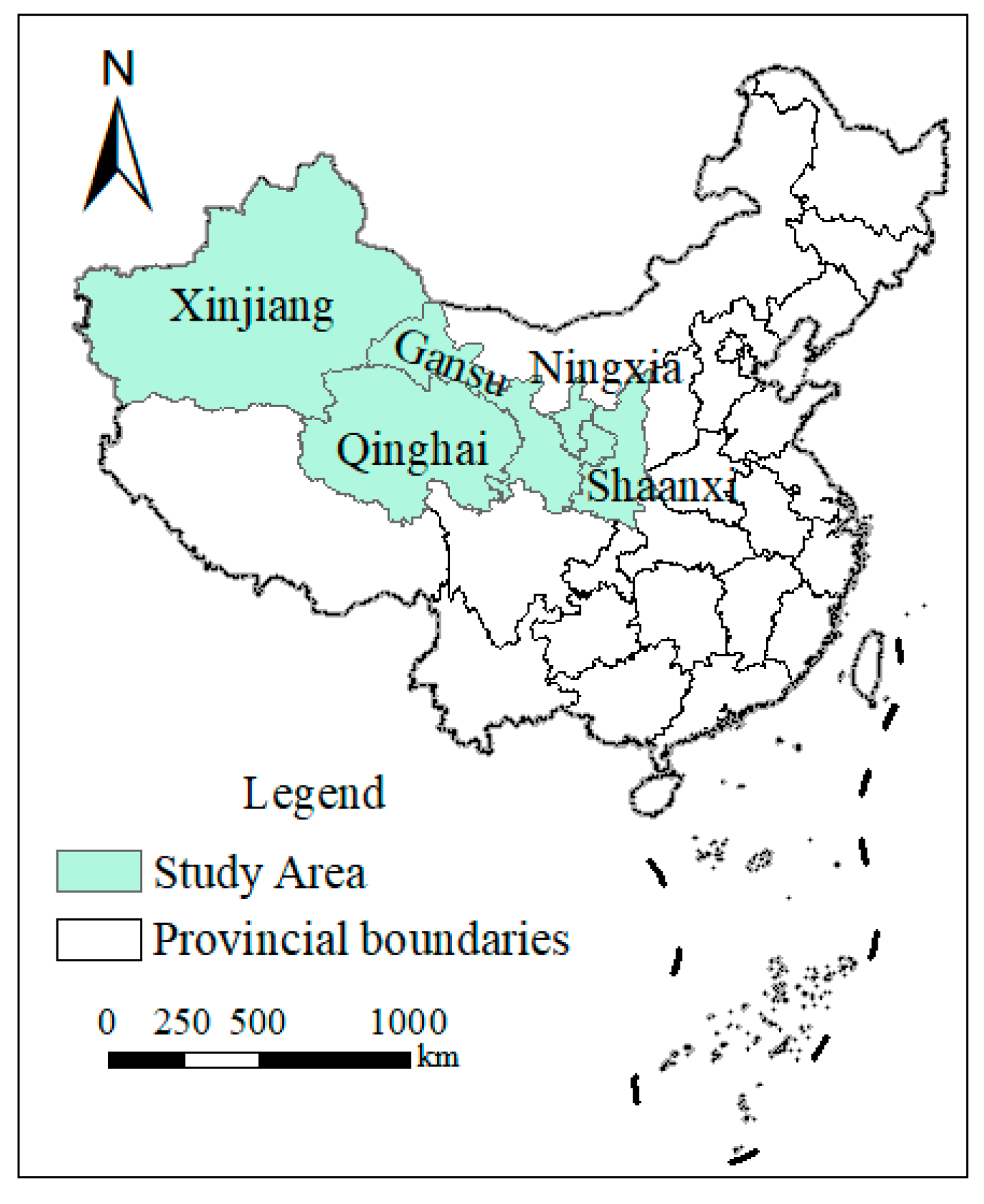
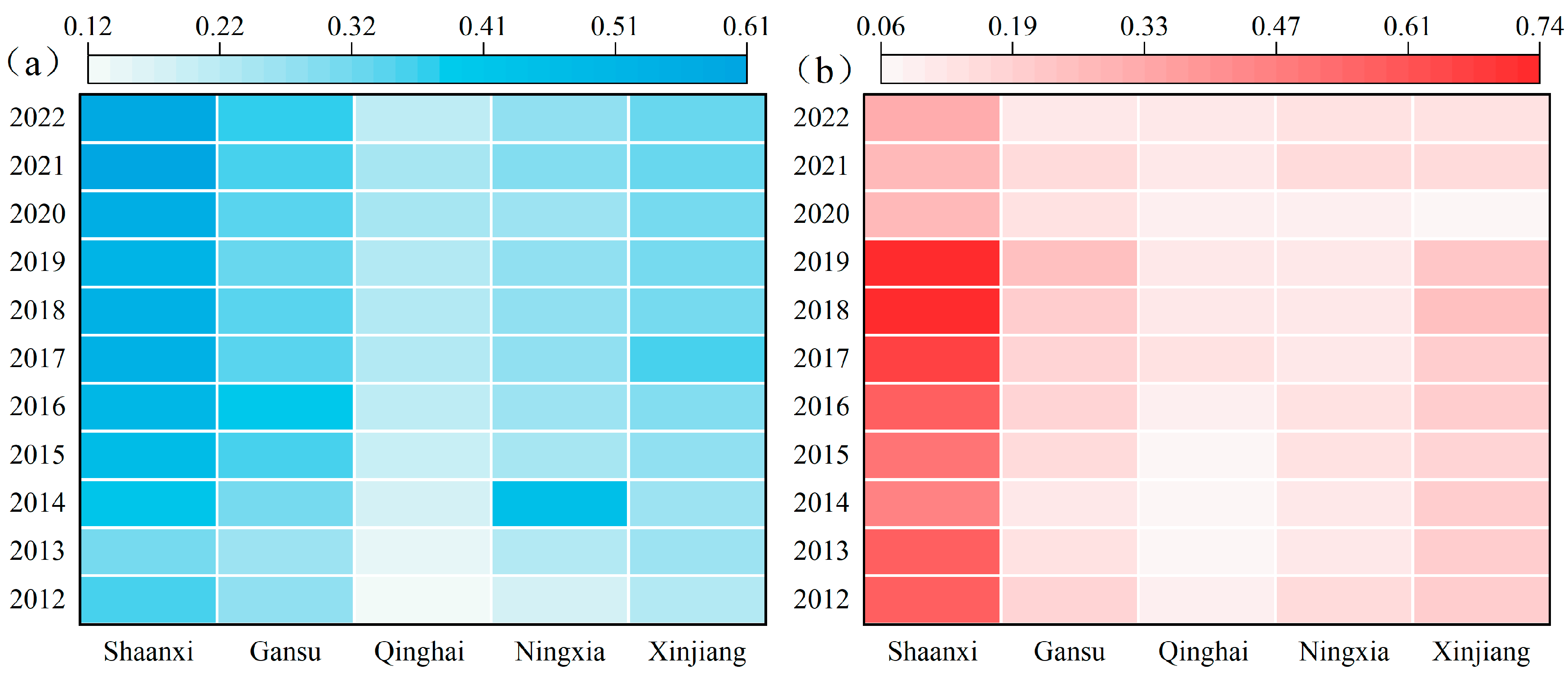
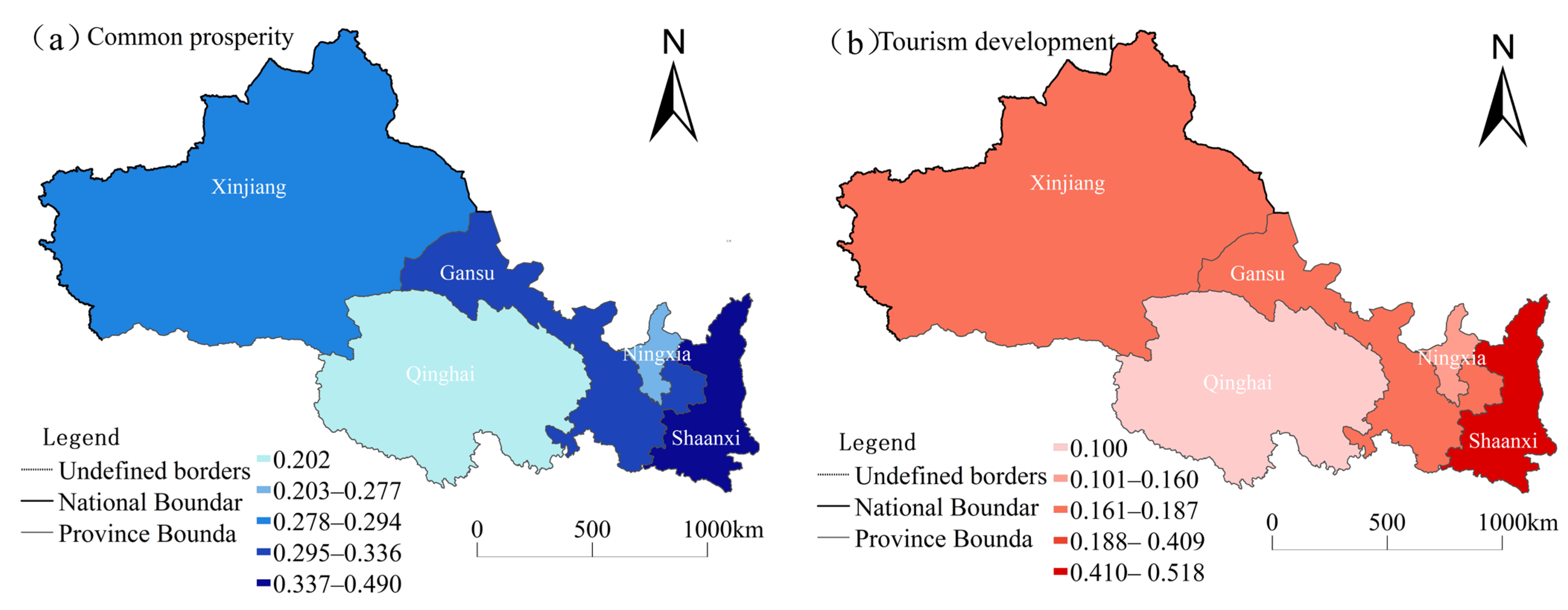
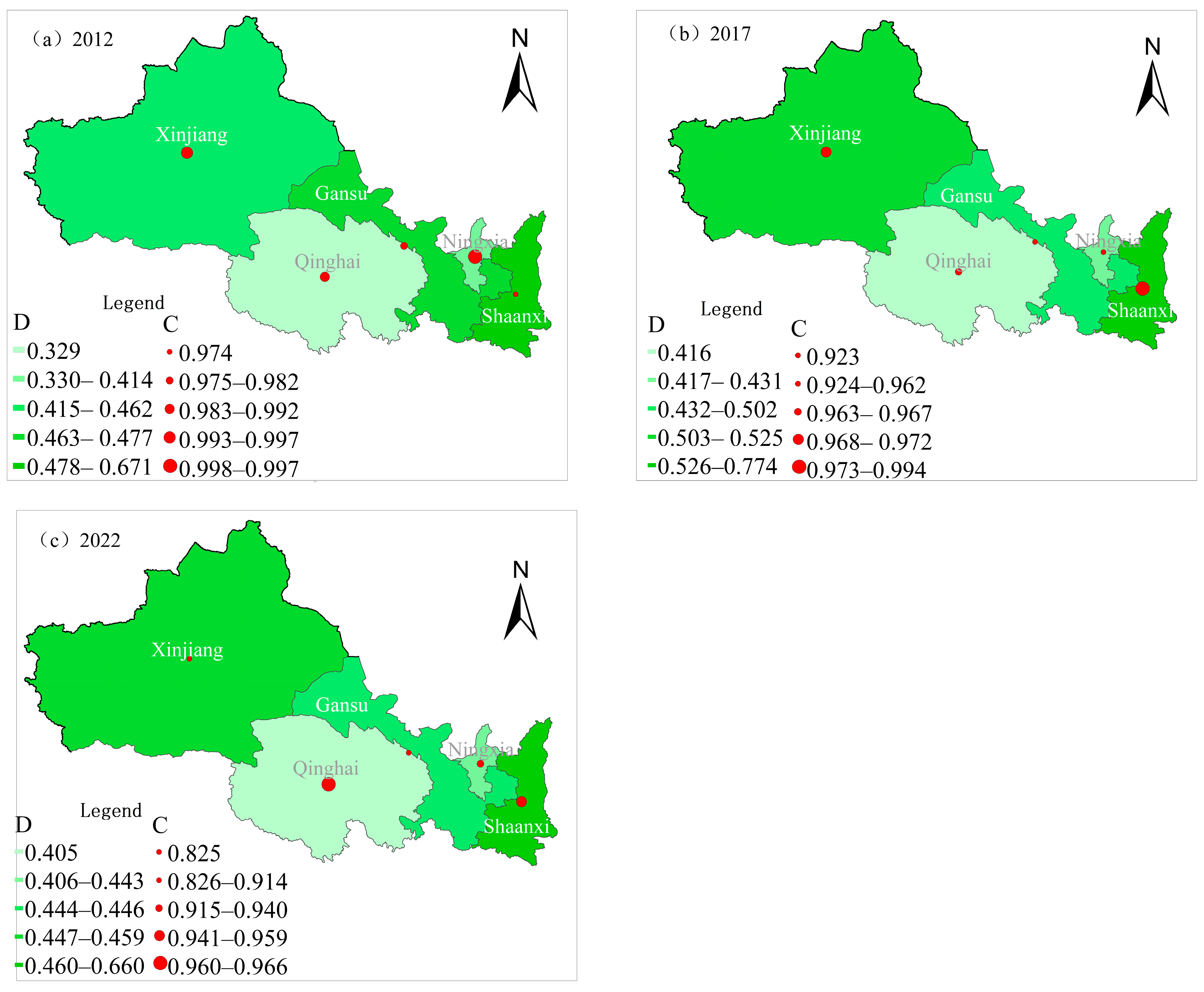
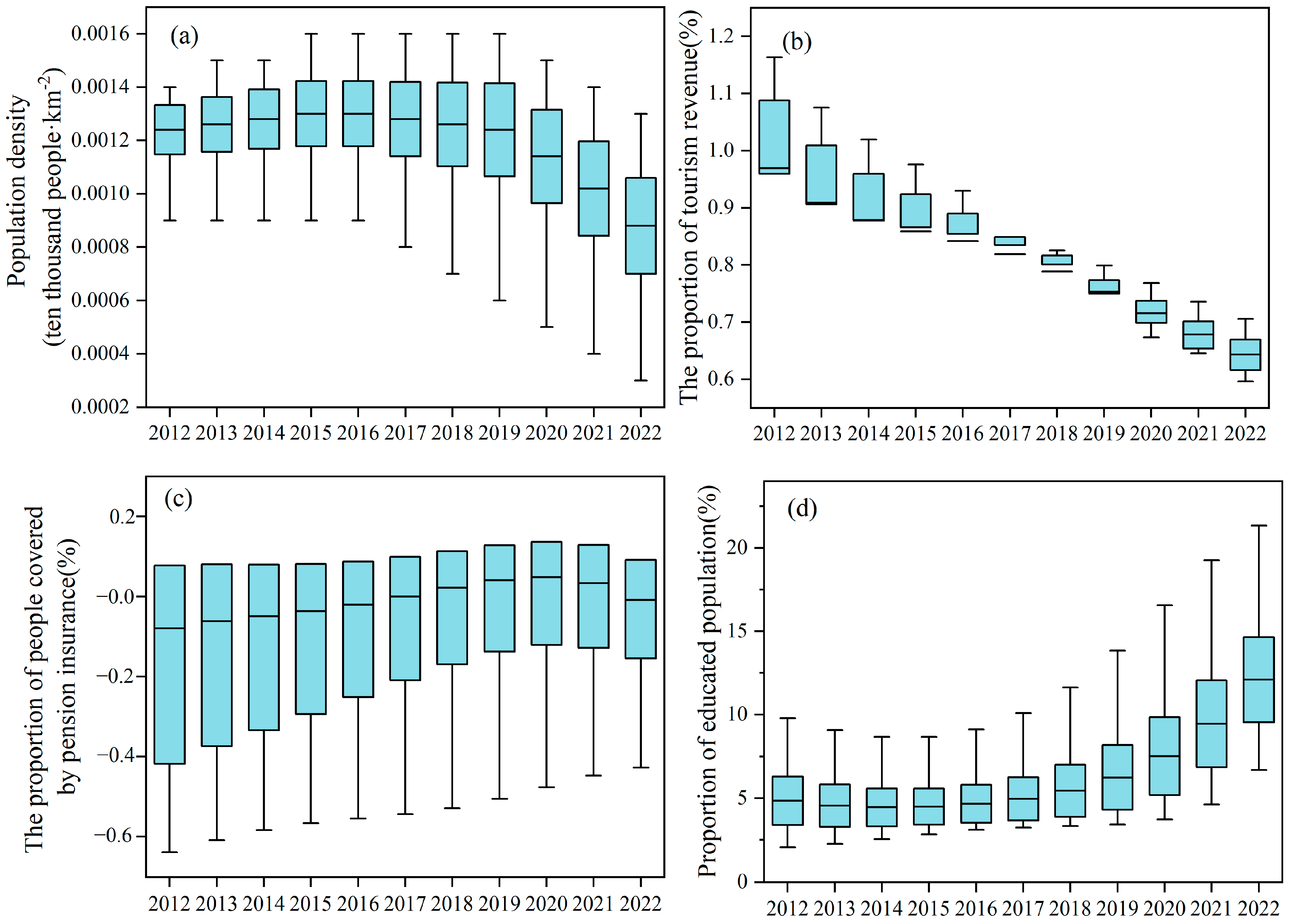
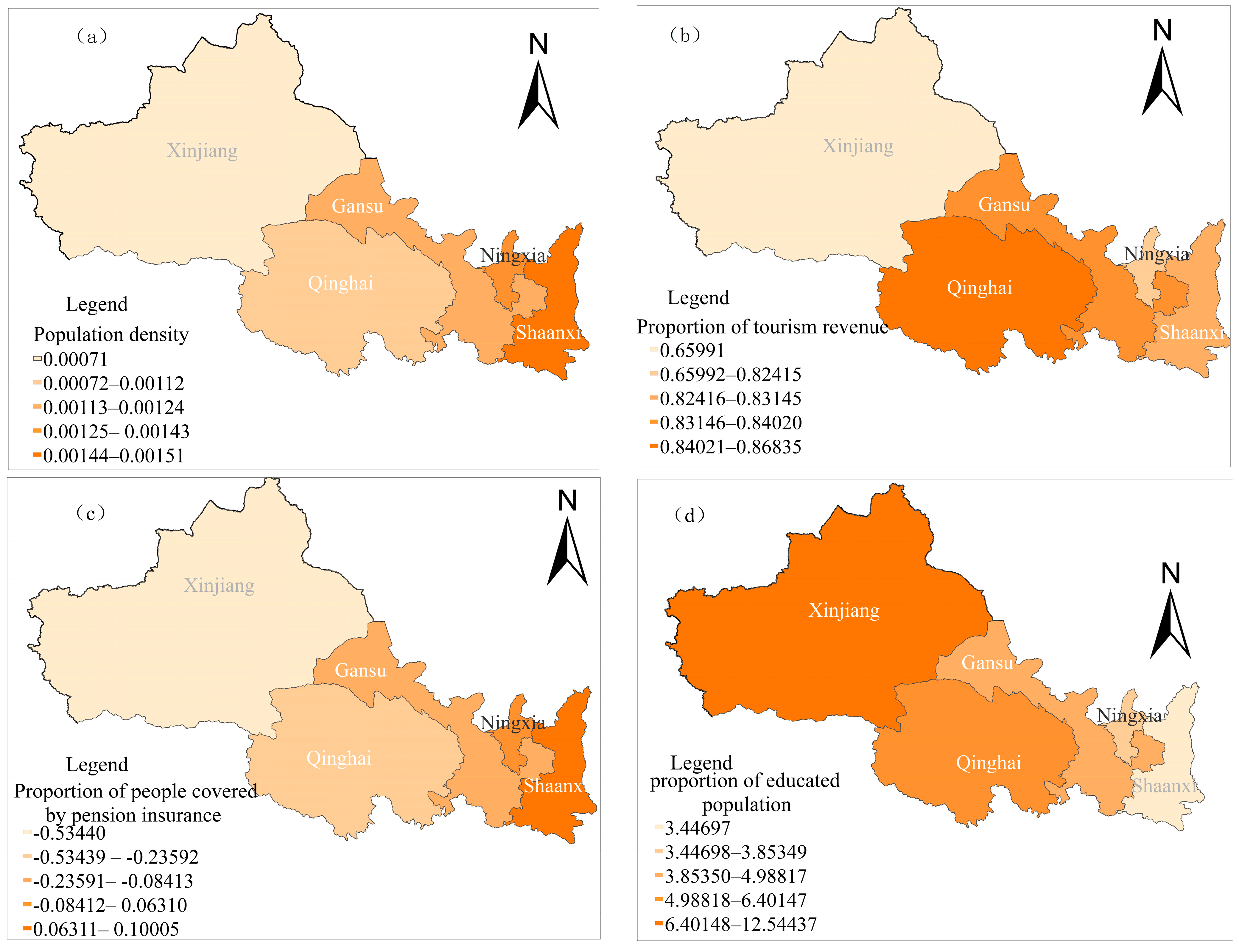
| System Level | Criterion Level | Indicator Level | Measurement Method | Attribute | Weight |
|---|---|---|---|---|---|
| Residents’ Common Prosperity | Developmental | Urban Income | Per capita disposable income of urban residents (CNY) | + | 0.0426 |
| Rural Income | Per capita disposable income of rural residents (CNY) | + | 0.0371 | ||
| Urban Consumption | Per capita consumption in urban areas (CNY) | + | 0.2361 | ||
| Rural Consumption | Per capita consumption in rural areas (CNY) | + | 0.0306 | ||
| Urban Living | Engel coefficient of urban residents | − | 0.0075 | ||
| Rural Living | Engel coefficient of rural residents | − | 0.0247 | ||
| Shared | Income Coordination Between Urban and Rural | Ratio of urban to rural residents’ income | + | 0.0292 | |
| Consumption Coordination Between Urban and Rural | Ratio of urban to rural residents’ consumption | + | 0.0410 | ||
| Cultural and Recreational Coordination | Ratio of per capita cultural and recreational expenditure of urban to rural residents | + | 0.0227 | ||
| Medical Coordination | Ratio of urban to rural medical beds | + | 0.0631 | ||
| Education Level | Number of graduates from higher education institutions per capita | + | 0.1366 | ||
| Social Infrastructure | Total investment in infrastructure construction (CNY 10,000) | + | 0.0863 | ||
| Spiritual Life | Number of library book loans per 10,000 people | + | 0.0470 | ||
| Engel Coefficient | Engel coefficient (%) | − | 0.0191 | ||
| Sustainability | Environmental Living | Sulfur dioxide emissions (10,000 tons) | − | 0.0308 | |
| Cultural Vitality | General public budget expenditure for culture, tourism, sports, and media (CNY 100 million) | + | 0.0596 | ||
| Social Structure | Urban unemployment rate (%) | − | 0.0140 | ||
| Technological Innovation | General public budget expenditure for science and technology (CNY 100 million) | + | 0.0718 | ||
| Tourism Development Level | Tourism Economy | Tourism Revenue | Total tourism revenue (CNY 100 million) | + | 0.1478 |
| Tourism Revenue Growth | Growth rate of total tourism revenue (%) | + | 0.0213 | ||
| Inbound Tourist Numbers | Number of inbound tourists (person-times) | + | 0.1657 | ||
| Reception Capacity | Travel Agency Reception Level | Domestic and inbound tourist reception by travel agencies (person-times) | + | 0.1503 | |
| Tourist Attraction Reception | Number of visitors to tourist attractions (billion person-times) | + | 0.1229 | ||
| Accommodation and Dining Reception Level | Ratio of the number of accommodation and dining establishments to total number of tourists (10,000 person-times) | + | 0.0870 | ||
| Infrastructure | Transportation Density | Passenger volume (10,000) to area (10,000 square kilometers) ratio | + | 0.1561 | |
| Total Passenger Volume | Total passenger transport volume in the region (10,000) | + | 0.1168 | ||
| Pollution Control | Proportion of environmental pollution control investment to GDP (%) | + | 0.0319 |
| Coupling Coordination Degree | Coupling Coordination Type | Coupling Coordination Degree | Coupling Coordination Type |
|---|---|---|---|
| (0.0, 0.1) | Extreme Imbalance | [0.5, 0.6) | Marginal Coordination |
| [0.1, 0.2) | Severe Imbalance | [0.6, 0.7) | Primary Coordination |
| [0.2, 0.3) | Moderate Imbalance | [0.7, 0.8) | Intermediate Coordination |
| [0.3, 0.4) | Mild Imbalance | [0.8, 0.9) | Good Coordination |
| [0.4, 0.5) | Near Imbalance | [0.9, 1.0) | High-Quality Coordination |
| Year | Province | ||||
|---|---|---|---|---|---|
| Shaanxi | Gansu | Qinghai | Ningxia | Xinjiang | |
| 2012 | 0.67 | 0.48 | 0.33 | 0.41 | 0.46 |
| 2013 | 0.65 | 0.44 | 0.33 | 0.39 | 0.48 |
| 2014 | 0.67 | 0.43 | 0.34 | 0.48 | 0.47 |
| 2015 | 0.70 | 0.49 | 0.35 | 0.42 | 0.48 |
| 2016 | 0.73 | 0.52 | 0.38 | 0.44 | 0.50 |
| 2017 | 0.77 | 0.50 | 0.42 | 0.43 | 0.52 |
| 2018 | 0.79 | 0.51 | 0.40 | 0.42 | 0.53 |
| 2019 | 0.79 | 0.53 | 0.39 | 0.42 | 0.52 |
| 2020 | 0.62 | 0.47 | 0.38 | 0.39 | 0.37 |
| 2021 | 0.64 | 0.50 | 0.40 | 0.47 | 0.48 |
| 2022 | 0.66 | 0.45 | 0.41 | 0.44 | 0.46 |
| Results of Linear Regression Analysis | ||||||
|---|---|---|---|---|---|---|
| t | p | VIF | R2 | Adj. R2 | F | |
| Constant | 7.642 | 0.000 ** | - | 0.840 | 0.822 | F = 48.167 p = 0.000 |
| GDP per capita | 1.717 | 0.093 | 1.347 | |||
| Population density | 6.081 | 0.000 ** | 2.427 | |||
| Proportion of tourism revenue | 7.125 | 0.000 ** | 1.32 | |||
| Proportion of people covered by pension insurance | −2.467 | 0.017 * | 2.05 | |||
| Proportion of educated population | 2.444 | 0.018 * | 2.887 | |||
Disclaimer/Publisher’s Note: The statements, opinions and data contained in all publications are solely those of the individual author(s) and contributor(s) and not of MDPI and/or the editor(s). MDPI and/or the editor(s) disclaim responsibility for any injury to people or property resulting from any ideas, methods, instructions or products referred to in the content. |
© 2025 by the authors. Licensee MDPI, Basel, Switzerland. This article is an open access article distributed under the terms and conditions of the Creative Commons Attribution (CC BY) license (https://creativecommons.org/licenses/by/4.0/).
Share and Cite
Zhu, H.; Mao, X.; Xie, X. Coupling Coordination Relationship and Driving Factors Between Common Prosperity and Tourism Development Levels in the Five Northwestern Provinces of China. Land 2025, 14, 1101. https://doi.org/10.3390/land14051101
Zhu H, Mao X, Xie X. Coupling Coordination Relationship and Driving Factors Between Common Prosperity and Tourism Development Levels in the Five Northwestern Provinces of China. Land. 2025; 14(5):1101. https://doi.org/10.3390/land14051101
Chicago/Turabian StyleZhu, Haiqiang, Xinru Mao, and Xia Xie. 2025. "Coupling Coordination Relationship and Driving Factors Between Common Prosperity and Tourism Development Levels in the Five Northwestern Provinces of China" Land 14, no. 5: 1101. https://doi.org/10.3390/land14051101
APA StyleZhu, H., Mao, X., & Xie, X. (2025). Coupling Coordination Relationship and Driving Factors Between Common Prosperity and Tourism Development Levels in the Five Northwestern Provinces of China. Land, 14(5), 1101. https://doi.org/10.3390/land14051101









